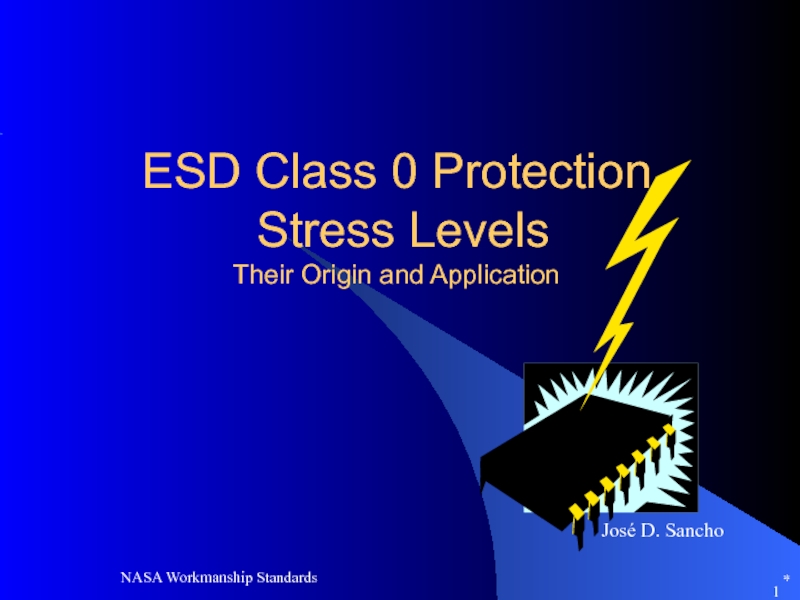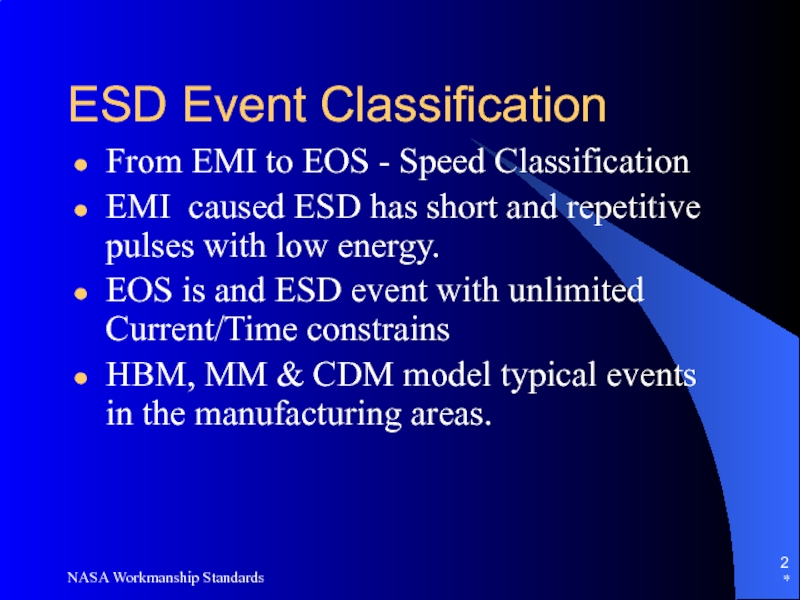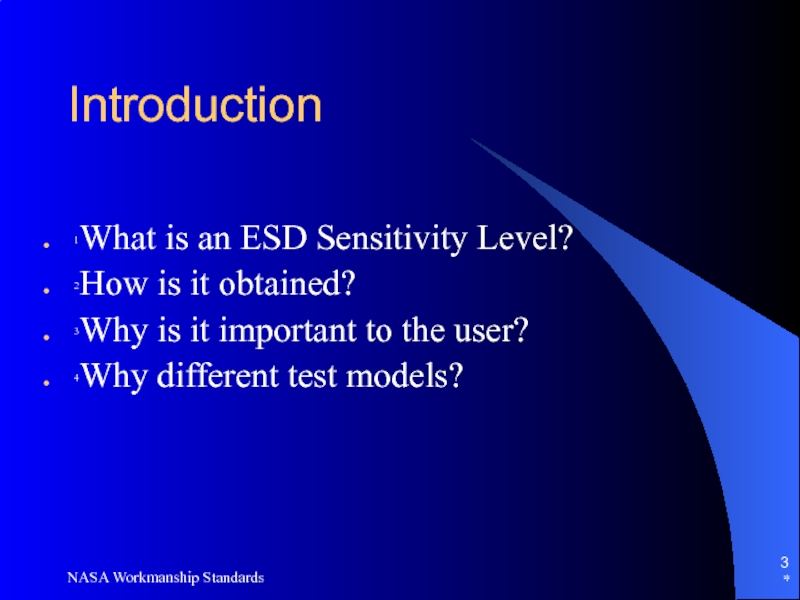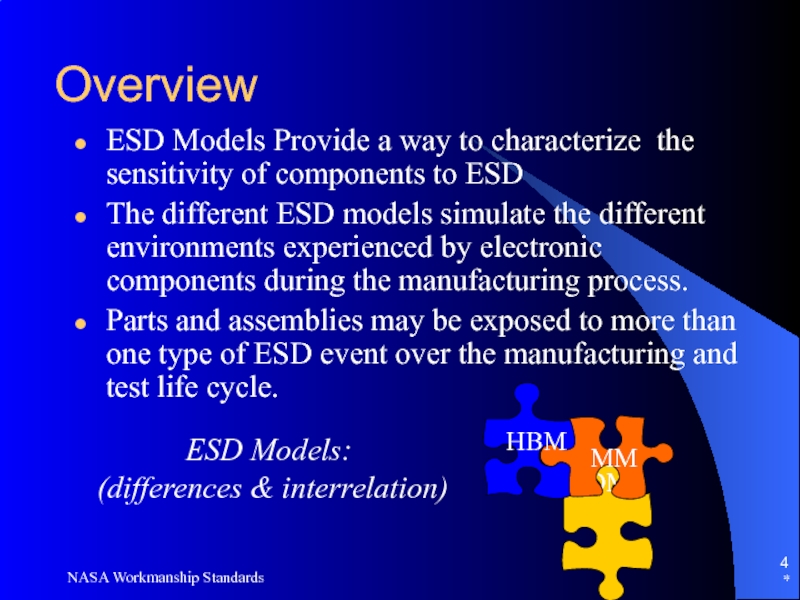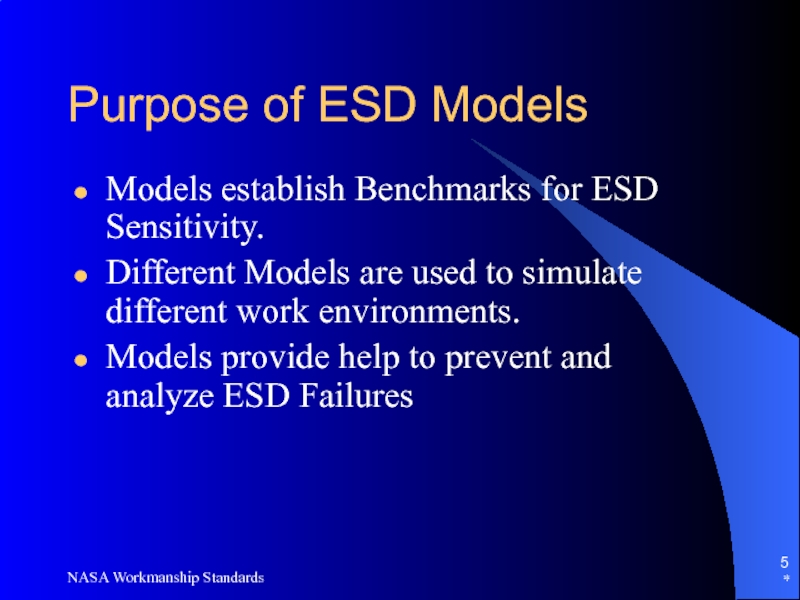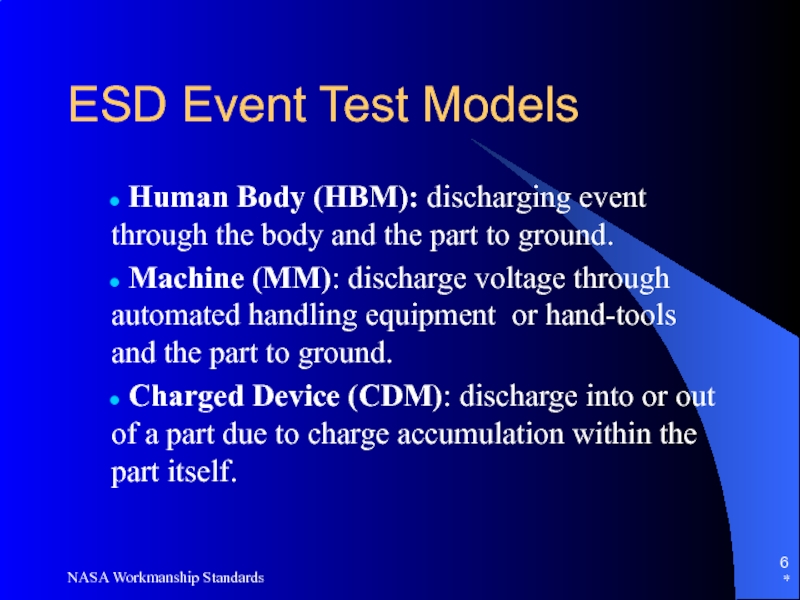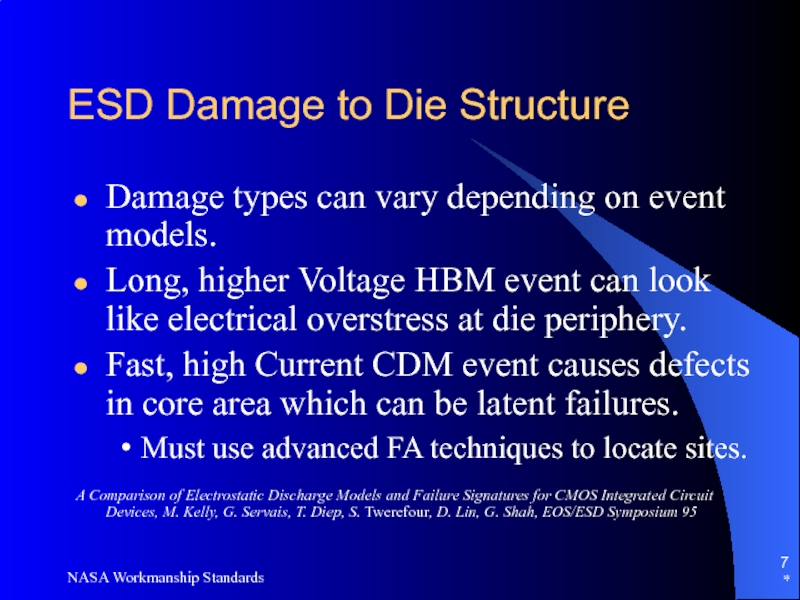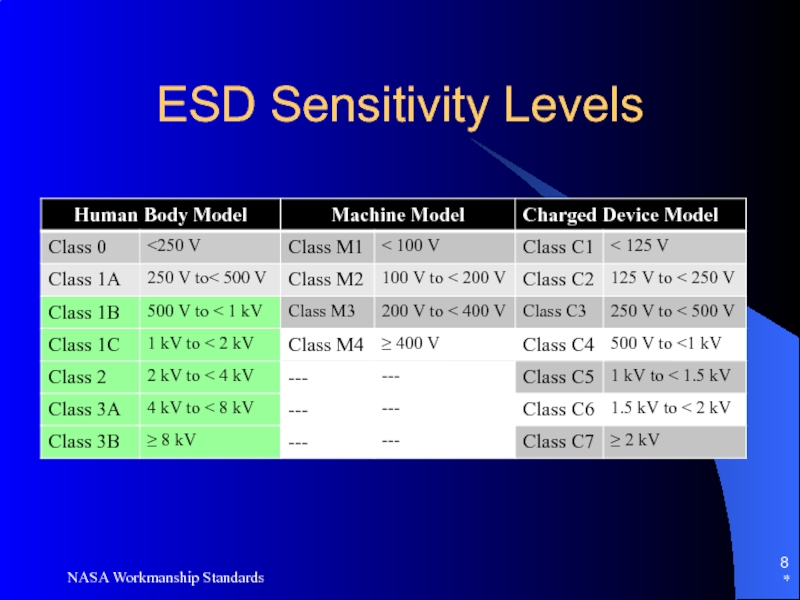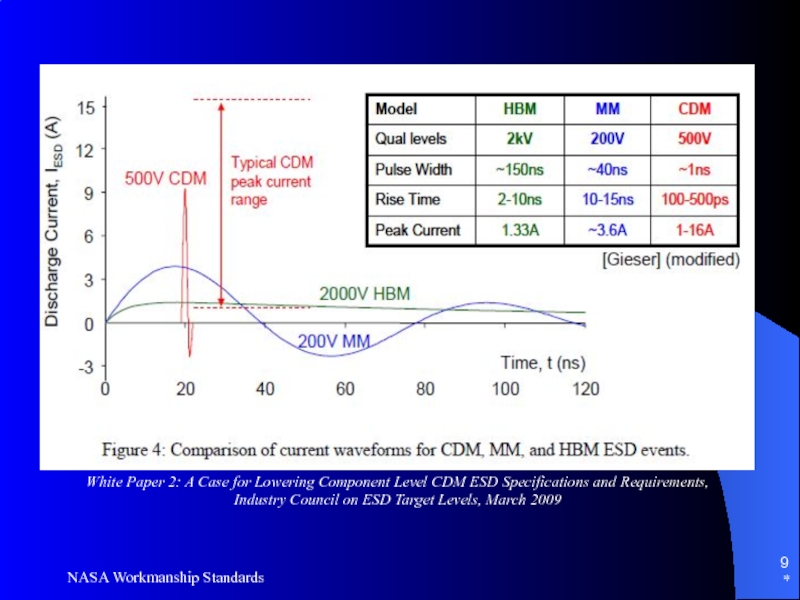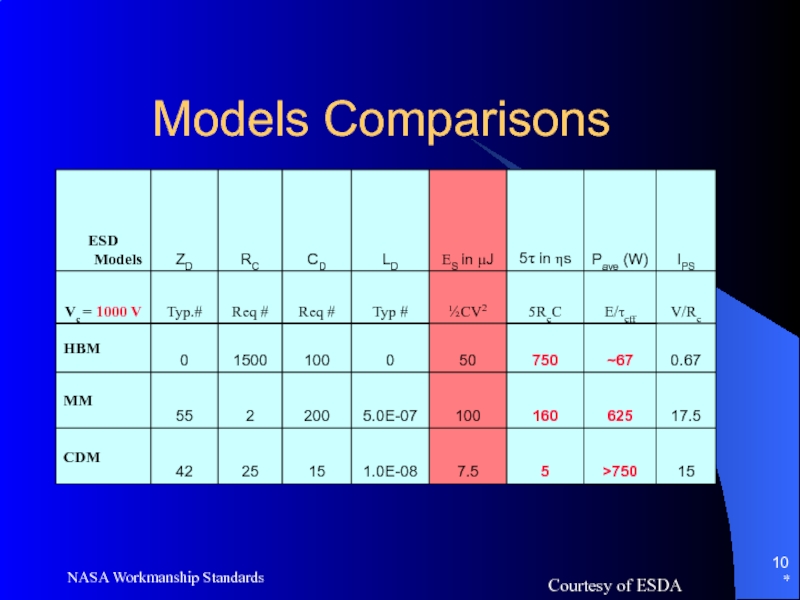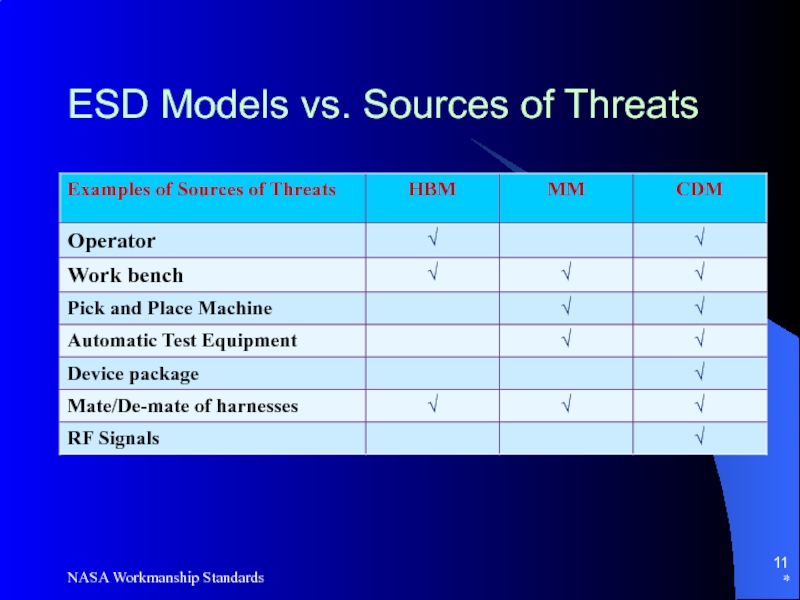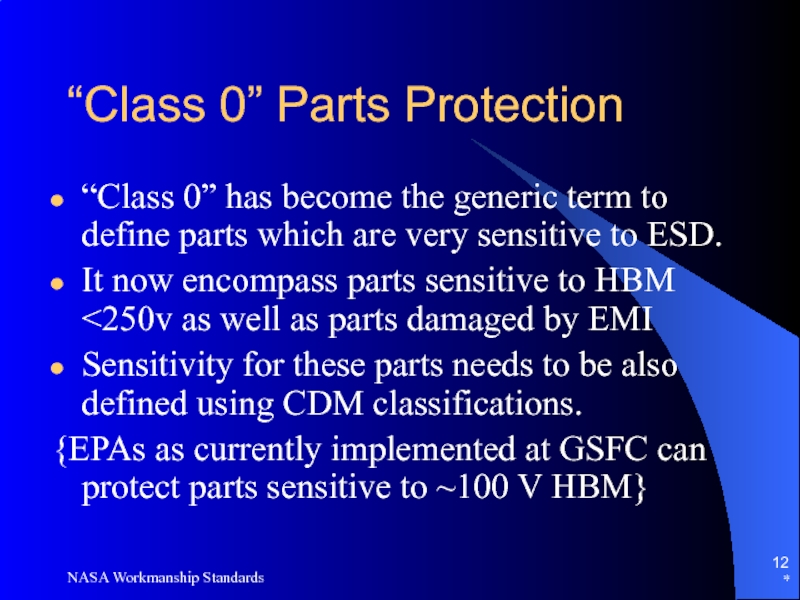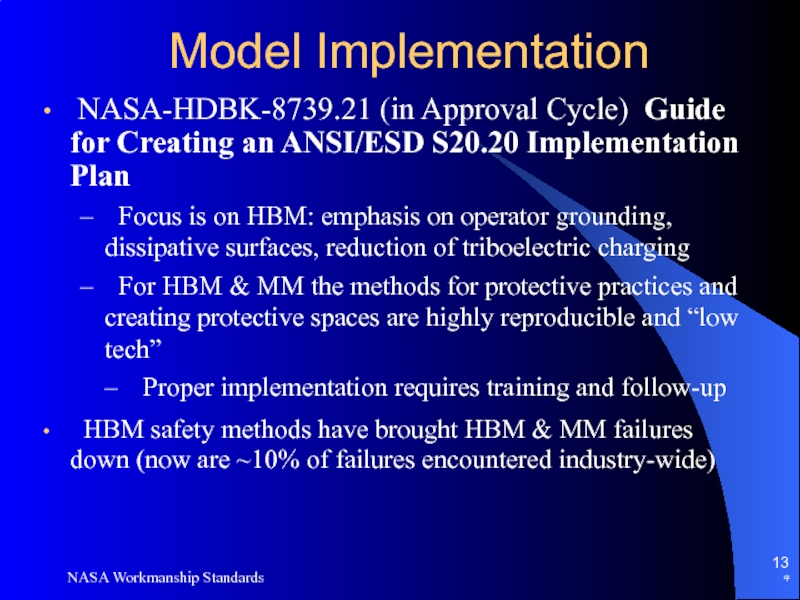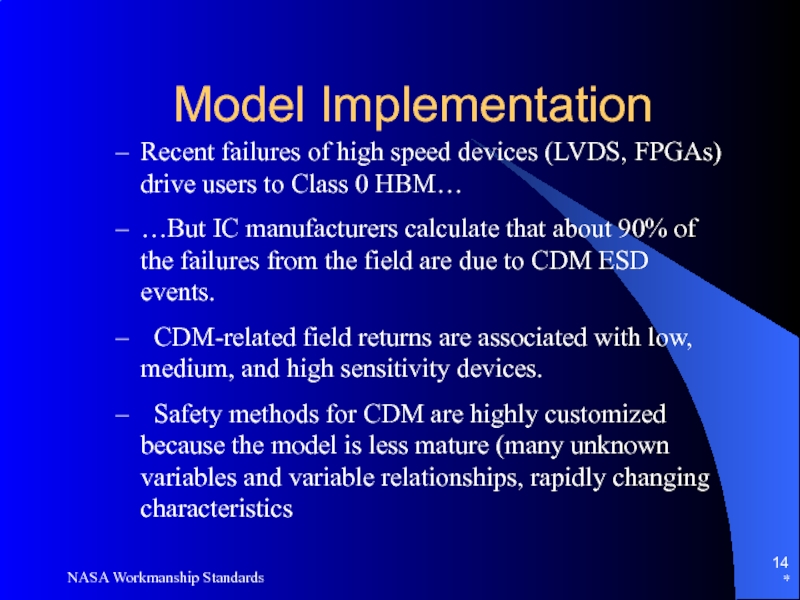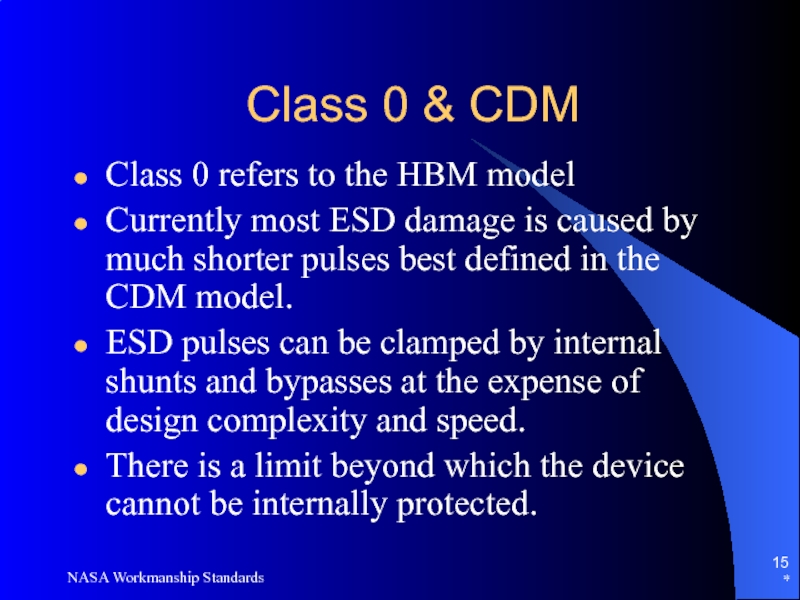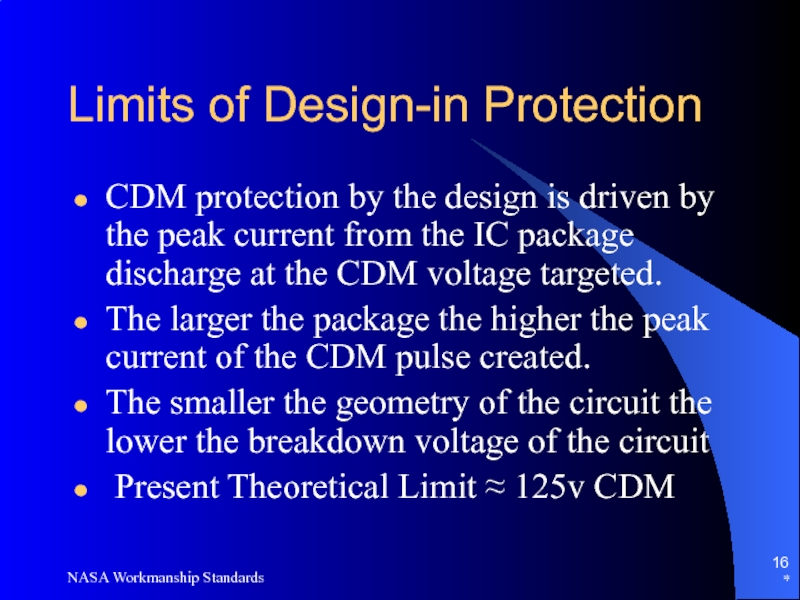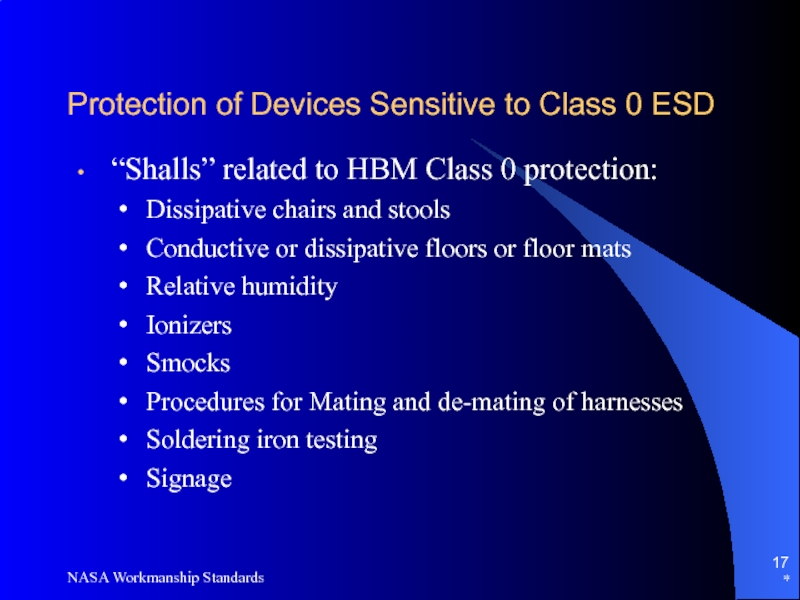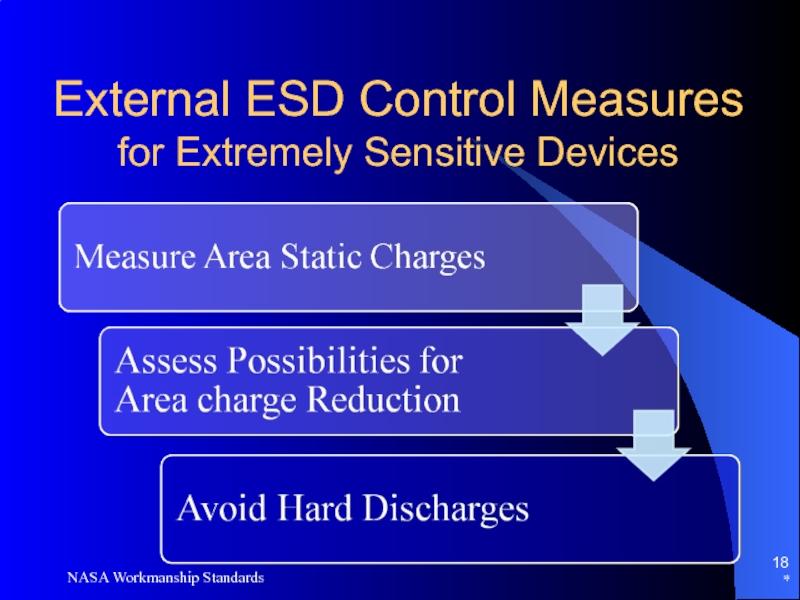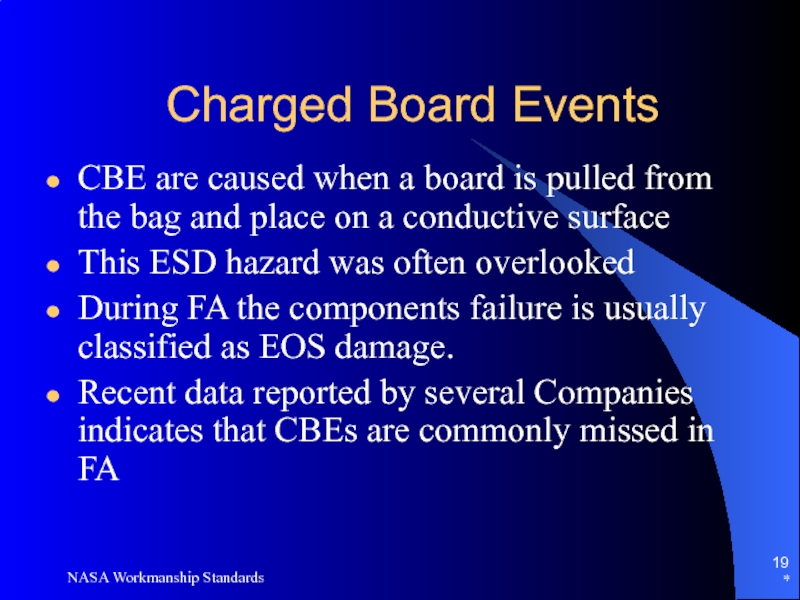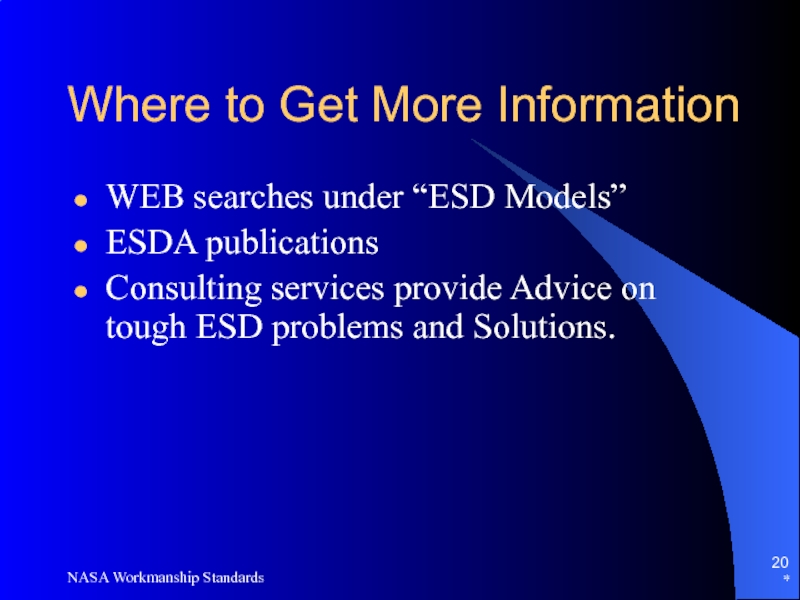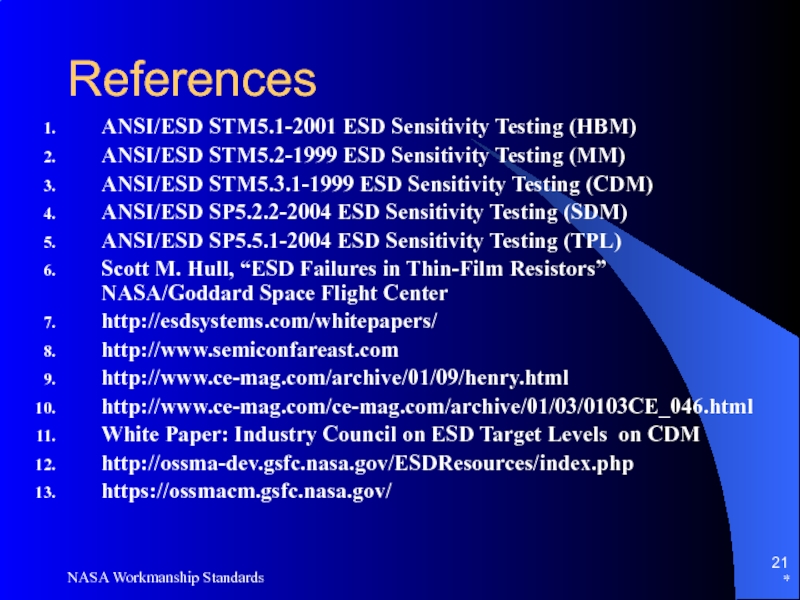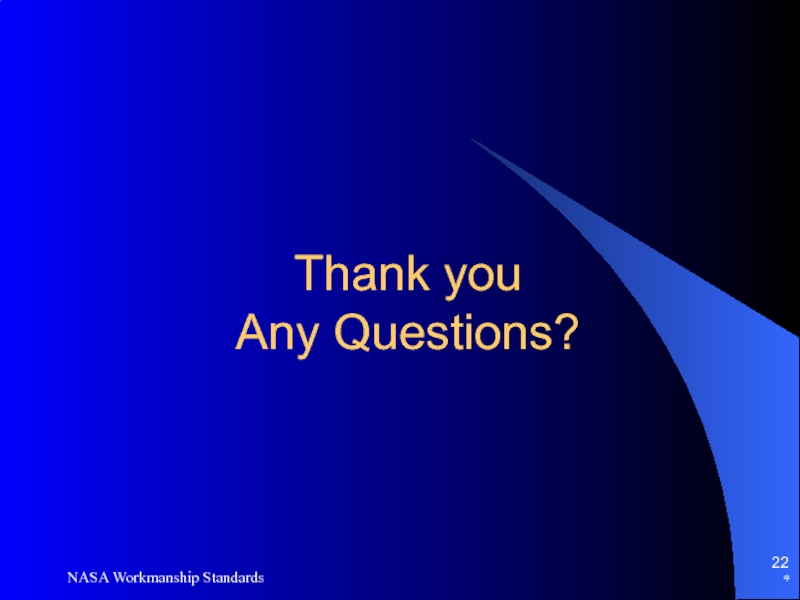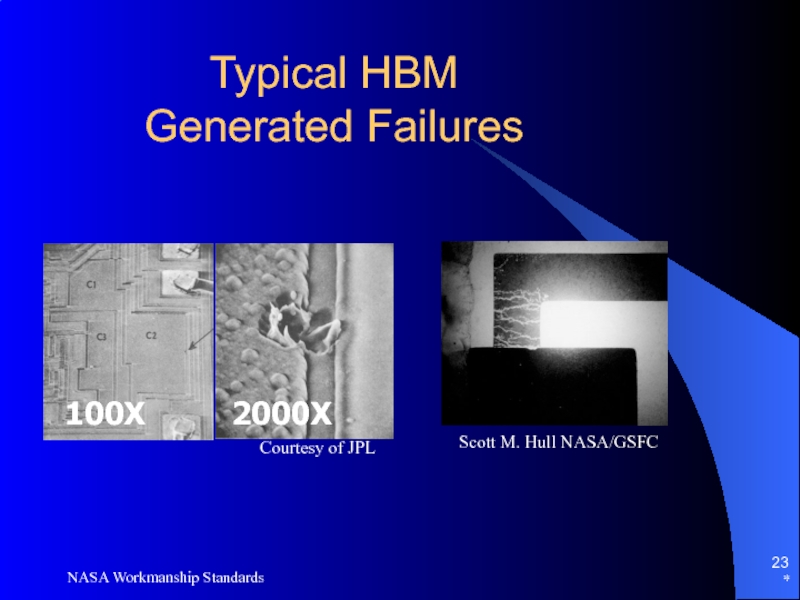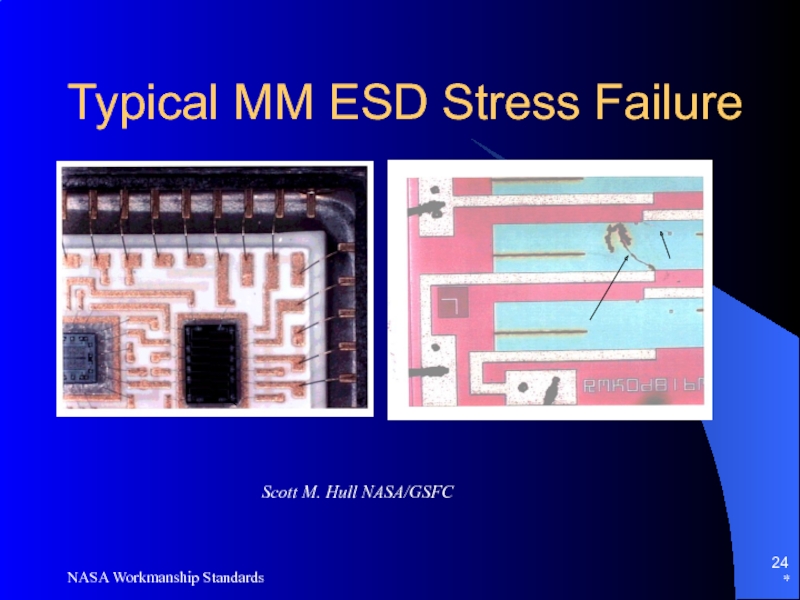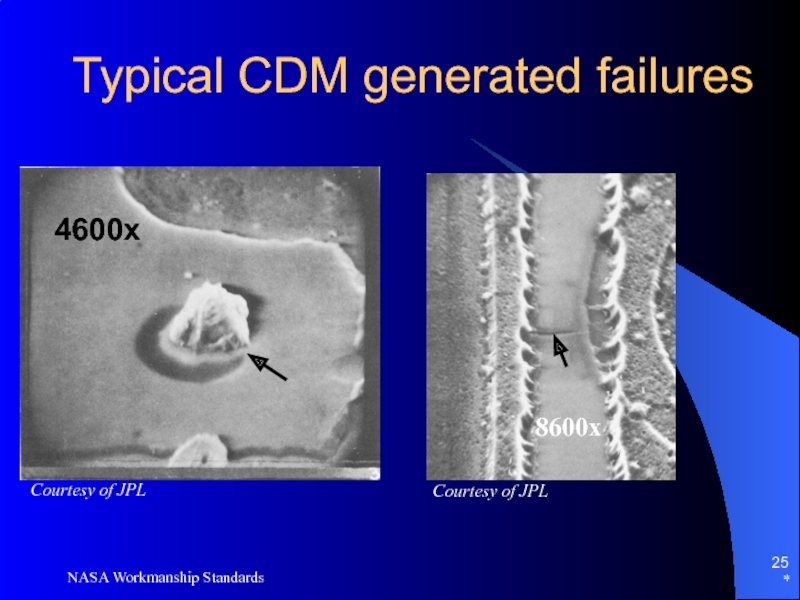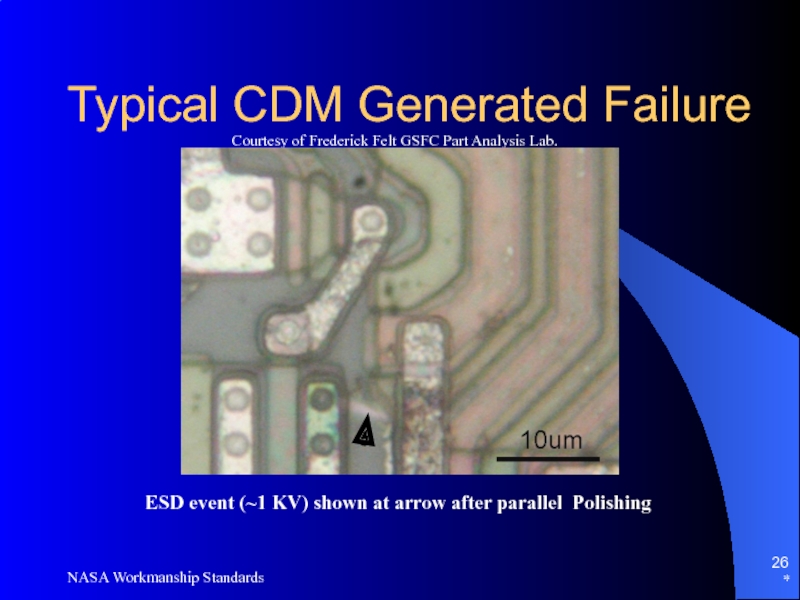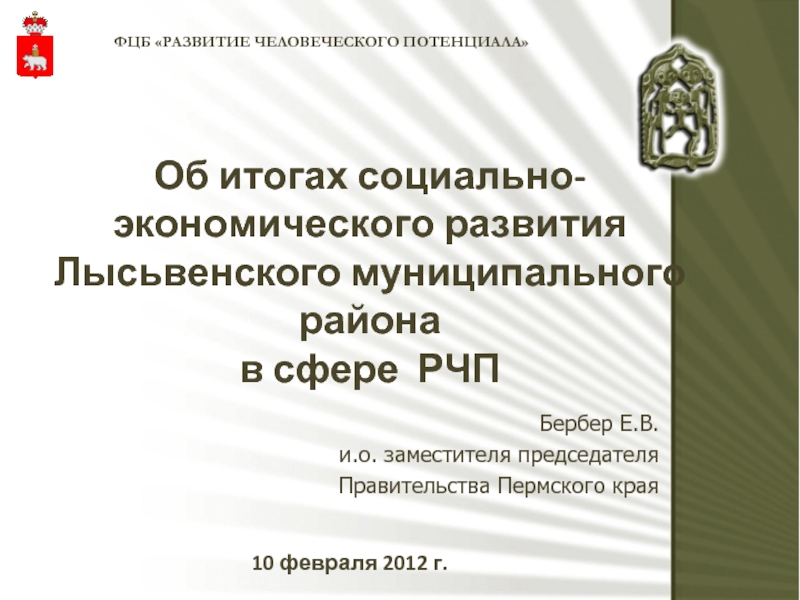- Главная
- Разное
- Дизайн
- Бизнес и предпринимательство
- Аналитика
- Образование
- Развлечения
- Красота и здоровье
- Финансы
- Государство
- Путешествия
- Спорт
- Недвижимость
- Армия
- Графика
- Культурология
- Еда и кулинария
- Лингвистика
- Английский язык
- Астрономия
- Алгебра
- Биология
- География
- Детские презентации
- Информатика
- История
- Литература
- Маркетинг
- Математика
- Медицина
- Менеджмент
- Музыка
- МХК
- Немецкий язык
- ОБЖ
- Обществознание
- Окружающий мир
- Педагогика
- Русский язык
- Технология
- Физика
- Философия
- Химия
- Шаблоны, картинки для презентаций
- Экология
- Экономика
- Юриспруденция
ESD Class 0 Protection Stress Levels презентация
Содержание
- 1. ESD Class 0 Protection Stress Levels
- 2. ESD Event Classification From EMI to EOS
- 3. * NASA Workmanship Standards Introduction 1What
- 4. * NASA Workmanship Standards Overview ESD
- 5. * NASA Workmanship Standards Purpose of ESD
- 6. * NASA Workmanship Standards Human Body
- 7. ESD Damage to Die Structure Damage types
- 8. ESD Sensitivity Levels * NASA Workmanship Standards
- 9. * NASA Workmanship Standards White Paper 2:
- 10. * NASA Workmanship Standards Models Comparisons Courtesy of ESDA
- 11. ESD Models vs. Sources of Threats * NASA Workmanship Standards
- 12. “Class 0” Parts Protection “Class 0” has
- 13. Model Implementation NASA-HDBK-8739.21 (in Approval Cycle)
- 14. Model Implementation Recent failures of high speed
- 15. Class 0 & CDM Class 0 refers
- 16. Limits of Design-in Protection CDM protection by
- 17. Protection of Devices Sensitive to Class 0
- 18. External ESD Control Measures for Extremely Sensitive Devices * NASA Workmanship Standards
- 19. Charged Board Events CBE are caused when
- 20. * NASA Workmanship Standards Where to Get
- 21. * NASA Workmanship Standards References ANSI/ESD STM5.1-2001
- 22. Thank you Any Questions? * NASA Workmanship Standards
- 23. * NASA Workmanship Standards Typical HBM Generated
- 24. * NASA Workmanship Standards Typical MM ESD Stress Failure Scott M. Hull NASA/GSFC
- 25. * NASA Workmanship Standards Typical CDM generated
- 26. * NASA Workmanship Standards Typical CDM Generated
Слайд 1*
NASA Workmanship Standards
José D. Sancho
ESD Class 0 Protection
Stress Levels
Their Origin
Слайд 2ESD Event Classification
From EMI to EOS - Speed Classification
EMI caused ESD
EOS is and ESD event with unlimited Current/Time constrains
HBM, MM & CDM model typical events in the manufacturing areas.
*
NASA Workmanship Standards
Слайд 3*
NASA Workmanship Standards
Introduction
1What is an ESD Sensitivity Level?
2How is it
3Why is it important to the user?
4Why different test models?
Слайд 4*
NASA Workmanship Standards
Overview
ESD Models Provide a way to characterize the
The different ESD models simulate the different environments experienced by electronic components during the manufacturing process.
Parts and assemblies may be exposed to more than one type of ESD event over the manufacturing and test life cycle.
CDM
MM
HBM
ESD Models:
(differences & interrelation)
Слайд 5*
NASA Workmanship Standards
Purpose of ESD Models
Models establish Benchmarks for ESD
Different Models are used to simulate different work environments.
Models provide help to prevent and analyze ESD Failures
Слайд 6*
NASA Workmanship Standards
Human Body (HBM): discharging event through the body
Machine (MM): discharge voltage through automated handling equipment or hand-tools and the part to ground.
Charged Device (CDM): discharge into or out of a part due to charge accumulation within the part itself.
ESD Event Test Models
Слайд 7ESD Damage to Die Structure
Damage types can vary depending on event
Long, higher Voltage HBM event can look like electrical overstress at die periphery.
Fast, high Current CDM event causes defects in core area which can be latent failures.
Must use advanced FA techniques to locate sites.
A Comparison of Electrostatic Discharge Models and Failure Signatures for CMOS Integrated Circuit Devices, M. Kelly, G. Servais, T. Diep, S. Twerefour, D. Lin, G. Shah, EOS/ESD Symposium 95
*
NASA Workmanship Standards
Слайд 9*
NASA Workmanship Standards
White Paper 2: A Case for Lowering Component Level
Слайд 12“Class 0” Parts Protection
“Class 0” has become the generic term to
It now encompass parts sensitive to HBM <250v as well as parts damaged by EMI
Sensitivity for these parts needs to be also defined using CDM classifications.
{EPAs as currently implemented at GSFC can protect parts sensitive to ~100 V HBM}
*
NASA Workmanship Standards
Слайд 13Model Implementation
NASA-HDBK-8739.21 (in Approval Cycle) Guide for Creating an ANSI/ESD
Focus is on HBM: emphasis on operator grounding, dissipative surfaces, reduction of triboelectric charging
For HBM & MM the methods for protective practices and creating protective spaces are highly reproducible and “low tech”
Proper implementation requires training and follow-up
HBM safety methods have brought HBM & MM failures down (now are ~10% of failures encountered industry-wide)
*
NASA Workmanship Standards
Слайд 14Model Implementation
Recent failures of high speed devices (LVDS, FPGAs) drive users
…But IC manufacturers calculate that about 90% of the failures from the field are due to CDM ESD events.
CDM-related field returns are associated with low, medium, and high sensitivity devices.
Safety methods for CDM are highly customized because the model is less mature (many unknown variables and variable relationships, rapidly changing characteristics
*
NASA Workmanship Standards
Слайд 15Class 0 & CDM
Class 0 refers to the HBM model
Currently most
ESD pulses can be clamped by internal shunts and bypasses at the expense of design complexity and speed.
There is a limit beyond which the device cannot be internally protected.
*
NASA Workmanship Standards
Слайд 16Limits of Design-in Protection
CDM protection by the design is driven by
The larger the package the higher the peak current of the CDM pulse created.
The smaller the geometry of the circuit the lower the breakdown voltage of the circuit
Present Theoretical Limit ≈ 125v CDM
*
NASA Workmanship Standards
Слайд 17Protection of Devices Sensitive to Class 0 ESD
“Shalls” related to
Dissipative chairs and stools
Conductive or dissipative floors or floor mats
Relative humidity
Ionizers
Smocks
Procedures for Mating and de-mating of harnesses
Soldering iron testing
Signage
*
NASA Workmanship Standards
Слайд 19Charged Board Events
CBE are caused when a board is pulled from
This ESD hazard was often overlooked
During FA the components failure is usually classified as EOS damage.
Recent data reported by several Companies indicates that CBEs are commonly missed in FA
*
NASA Workmanship Standards
Слайд 20*
NASA Workmanship Standards
Where to Get More Information
WEB searches under “ESD Models”
ESDA
Consulting services provide Advice on tough ESD problems and Solutions.
Слайд 21*
NASA Workmanship Standards
References
ANSI/ESD STM5.1-2001 ESD Sensitivity Testing (HBM)
ANSI/ESD STM5.2-1999 ESD Sensitivity
ANSI/ESD STM5.3.1-1999 ESD Sensitivity Testing (CDM)
ANSI/ESD SP5.2.2-2004 ESD Sensitivity Testing (SDM)
ANSI/ESD SP5.5.1-2004 ESD Sensitivity Testing (TPL)
Scott M. Hull, “ESD Failures in Thin-Film Resistors” NASA/Goddard Space Flight Center
http://esdsystems.com/whitepapers/
http://www.semiconfareast.com
http://www.ce-mag.com/archive/01/09/henry.html
http://www.ce-mag.com/ce-mag.com/archive/01/03/0103CE_046.html
White Paper: Industry Council on ESD Target Levels on CDM
http://ossma-dev.gsfc.nasa.gov/ESDResources/index.php
https://ossmacm.gsfc.nasa.gov/
Слайд 23*
NASA Workmanship Standards
Typical HBM Generated Failures
2000X
100X
Courtesy of JPL
Scott M. Hull NASA/GSFC
Слайд 25*
NASA Workmanship Standards
Typical CDM generated failures
4600x
8600x
Courtesy of JPL
Courtesy of JPL
Слайд 26*
NASA Workmanship Standards
Typical CDM Generated Failure
Courtesy of Frederick Felt GSFC Part
ESD event (~1 KV) shown at arrow after parallel Polishing
